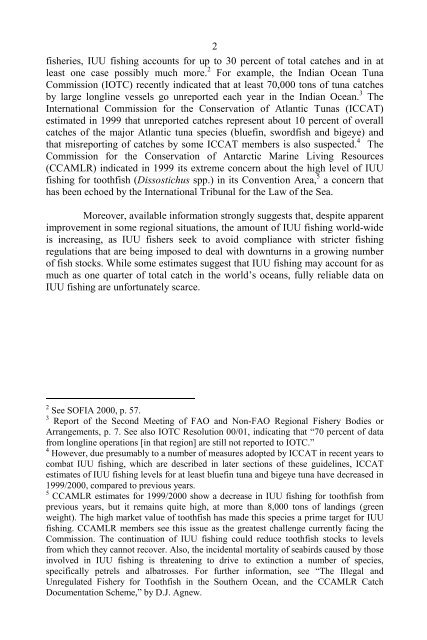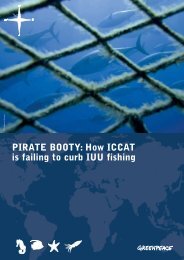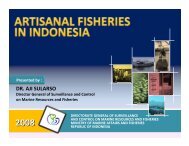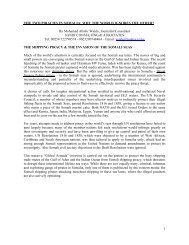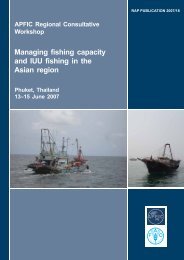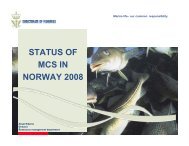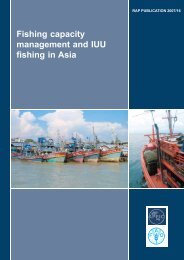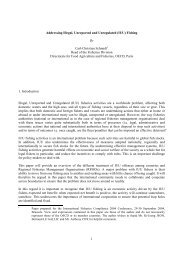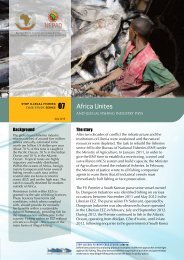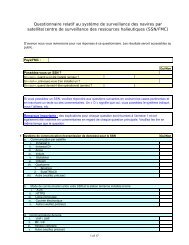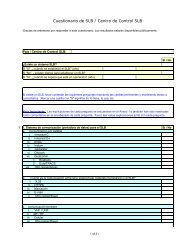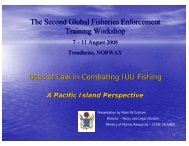1. INTERNATIONAL PLAN OF ACTION – <strong>IUU</strong>1.1 Origin and Purpose <strong>of</strong> the <strong>IPOA</strong>-<strong>IUU</strong>Illegal, unreported and unregulated (<strong>IUU</strong>) fishing occurs in virtually allcapture fisheries, whether they are conducted within areas under nationaljurisdiction or on the high seas. <strong>IUU</strong> fishing poses a direct and significant threatto effective conservation and management <strong>of</strong> many fish stocks, causing multipleadverse consequences for fisheries and for the people who depend on them in thepursuit <strong>of</strong> their legitimate livelihoods.By frustrating fishery management objectives, <strong>IUU</strong> fishing can lead tothe collapse <strong>of</strong> a fishery or seriously impair efforts to rebuild depleted fishstocks. This, in turn, may result in lost economic and social opportunities, bothshort-term and long-term, and may diminish food security. Left unchecked, <strong>IUU</strong>fishing can completely negate the benefits <strong>of</strong> effective fisheries management.Those who conduct <strong>IUU</strong> fishing are also unlikely to observe rulesdesigned to protect the marine environment from the harmful effects <strong>of</strong> somefishing activity, including, for example, restrictions on the harvest <strong>of</strong> juvenilefish, gear restrictions established to minimize waste and bycatch <strong>of</strong> non-targetspecies, and prohibitions on fishing in known spawning areas. To avoiddetection, <strong>IUU</strong> fishers <strong>of</strong>ten violate certain basic safety requirements, such askeeping navigation lights lit at night, which puts other users <strong>of</strong> the oceans at risk.Operators <strong>of</strong> <strong>IUU</strong> vessels also tend to deny to crew members fundamental rightsconcerning the terms and conditions <strong>of</strong> their labour, including those concerningwages, safety standards and other living and working conditions.In addition to its detrimental economic, social, environmental and safetyconsequences, the unfairness <strong>of</strong> <strong>IUU</strong> fishing raises serious concerns. Bydefinition, <strong>IUU</strong> fishing is either an expressly illegal activity or, at a minimum, anactivity undertaken with little regard for applicable standards. <strong>IUU</strong> fishers gainan unjust advantage over legitimate fishers; i.e. those who operate in accordancewith those standards. In this sense, <strong>IUU</strong> fishers are “free riders” who benefitunfairly from the sacrifices made by others for the sake <strong>of</strong> proper fisheriesconservation and management. This situation undermines the morale <strong>of</strong>legitimate fishers and, perhaps more importantly, encourages them to disregardthe rules as well. Thus, <strong>IUU</strong> fishing tends to promote additional <strong>IUU</strong> fishing,creating a downward cycle <strong>of</strong> management failure. 1The unreported nature <strong>of</strong> <strong>IUU</strong> fishing makes it particularly difficult toquantify. Available information nevertheless indicates that, for some important1 For further discussion, see “Dealing with the ‘Bad Actors’ <strong>of</strong> Ocean Fisheries, ” byDavid Balton.
2fisheries, <strong>IUU</strong> fishing accounts for up to 30 percent <strong>of</strong> total catches and in atleast one case possibly much more. 2 For example, the Indian Ocean TunaCommission (IOTC) recently indicated that at least 70,000 tons <strong>of</strong> tuna catchesby large longline vessels go unreported each year in the Indian Ocean. 3 The<strong>International</strong> Commission for the Conservation <strong>of</strong> Atlantic Tunas (ICCAT)estimated in 1999 that unreported catches represent about 10 percent <strong>of</strong> overallcatches <strong>of</strong> the major Atlantic tuna species (bluefin, swordfish and bigeye) andthat misreporting <strong>of</strong> catches by some ICCAT members is also suspected. 4 TheCommission for the Conservation <strong>of</strong> Antarctic Marine Living Resources(CCAMLR) indicated in 1999 its extreme concern about the high level <strong>of</strong> <strong>IUU</strong>fishing for toothfish (Dissostichus spp.) in its Convention Area, 5 a concern thathas been echoed by the <strong>International</strong> Tribunal for the Law <strong>of</strong> the Sea.Moreover, available information strongly suggests that, despite apparentimprovement in some regional situations, the amount <strong>of</strong> <strong>IUU</strong> fishing world-wideis increasing, as <strong>IUU</strong> fishers seek to avoid compliance with stricter fishingregulations that are being imposed to deal with downturns in a growing number<strong>of</strong> fish stocks. While some estimates suggest that <strong>IUU</strong> fishing may account for asmuch as one quarter <strong>of</strong> total catch in the world’s oceans, fully reliable data on<strong>IUU</strong> fishing are unfortunately scarce.2 See SOFIA 2000, p. 57.3 Report <strong>of</strong> the Second Meeting <strong>of</strong> FAO and Non-FAO Regional Fishery Bodies orArrangements, p. 7. See also IOTC Resolution 00/01, indicating that “70 percent <strong>of</strong> datafrom longline operations [in that region] are still not reported to IOTC.”4 However, due presumably to a number <strong>of</strong> measures adopted by ICCAT in recent years tocombat <strong>IUU</strong> fishing, which are described in later sections <strong>of</strong> these guidelines, ICCATestimates <strong>of</strong> <strong>IUU</strong> fishing levels for at least bluefin tuna and bigeye tuna have decreased in1999/2000, compared to previous years.5 CCAMLR estimates for 1999/2000 show a decrease in <strong>IUU</strong> fishing for toothfish fromprevious years, but it remains quite high, at more than 8,000 tons <strong>of</strong> landings (greenweight). The high market value <strong>of</strong> toothfish has made this species a prime target for <strong>IUU</strong>fishing. CCAMLR members see this issue as the greatest challenge currently facing theCommission. The continuation <strong>of</strong> <strong>IUU</strong> fishing could reduce toothfish stocks to levelsfrom which they cannot recover. Also, the incidental mortality <strong>of</strong> seabirds caused by thoseinvolved in <strong>IUU</strong> fishing is threatening to drive to extinction a number <strong>of</strong> species,specifically petrels and albatrosses. For further information, see “The Illegal andUnregulated Fishery for Toothfish in the Southern Ocean, and the CCAMLR CatchDocumentation Scheme,” by D.J. Agnew.
- Page 4 and 5: iiiPREPARATION OF THIS DOCUMENTThe
- Page 6 and 7: vThe IPOA-IUU is voluntary. However
- Page 8 and 9: viii6.2 Examples of some port State
- Page 10 and 11: xiBACKGROUND1. From ancient times,
- Page 12 and 13: xiii11. The Code is voluntary. Howe
- Page 16 and 17: 3Since the late 1990s, a number of
- Page 18 and 19: 5(1) conducted by national or forei
- Page 20 and 21: 7flag States, coastal States and Po
- Page 22 and 23: 9In light of this, the very first
- Page 24 and 25: 11the vessels rarely if ever visit
- Page 26 and 27: 13For example, Japan requires its n
- Page 28 and 29: 15IUU fishing on the high seas. 27
- Page 30 and 31: 17end all forms of government econo
- Page 32 and 33: 19developing States, 36 have introd
- Page 34 and 35: 21If the vessel is fishing on the h
- Page 36 and 37: 23registering a vessel that has a h
- Page 38 and 39: 25RFMOs have a role to play in ensu
- Page 40 and 41: 27FAO, in turn, will make available
- Page 42 and 43: 29species can be caught, what gear
- Page 44 and 45: 31Flag States are also encouraged t
- Page 46 and 47: 33cases, fishing vessels registered
- Page 48: 35light of this, paragraph 51 of th
- Page 51 and 52: 38transshipment at sea is prohibite
- Page 53 and 54: 40supported IUU fishing. For exampl
- Page 55 and 56: 42Japan prohibits port calls by tun
- Page 57 and 58: 44of a NAFO member, it must be insp
- Page 59 and 60: 46discussed in Section 7 of these g
- Page 61 and 62: 48products harvested through IUU fi
- Page 63 and 64: 50products. On the basis of that da
- Page 65 and 66:
52question, while the latter only c
- Page 67 and 68:
54States can also combat IUU fishin
- Page 69 and 70:
56RFMOs engage in IUU fishing. No s
- Page 71 and 72:
588.3 Possibilities for Further Act
- Page 73 and 74:
60resolutions calling on those memb
- Page 75 and 76:
62landings, port control, and inspe
- Page 77 and 78:
648.3.8 Actions in Response to Rema
- Page 79 and 80:
66As a result, IUU fishers often co
- Page 81 and 82:
68A number of other developed State
- Page 83 and 84:
702.4 Measures to control transport
- Page 85 and 86:
10.3 Suggested Format for Reports t
- Page 87 and 88:
74Flag States should closely contro
- Page 89 and 90:
76A coastal State should consider r
- Page 91 and 92:
78To assist States in implementing
- Page 93 and 94:
12. LITERATURE CITED80Agnew, D.J. 2
- Page 95 and 96:
82Greenpeace. 2001. Pirate Fishing:
- Page 97 and 98:
84II. NATURE AND SCOPE OF IUU FISHI
- Page 99 and 100:
86to the Conservation and Managemen
- Page 101 and 102:
National Legislation88Legislation16
- Page 103 and 104:
90National Plans of Action25. State
- Page 105 and 106:
9236.2 having taken into account al
- Page 107 and 108:
9446.3 the species, fishing gear au
- Page 109 and 110:
9651.2 cooperation and exchange of
- Page 111 and 112:
98general operating guidelines for
- Page 113 and 114:
100and should consider measures to
- Page 115 and 116:
10280.9 development of observer pro
- Page 117 and 118:
10486.3 the strengthening of region
- Page 119 and 120:
106Articles V, VI, and VII of the A
- Page 121 and 122:
1084.2 To the greatest extent pract
- Page 123 and 124:
110• Compliance with other aspect
- Page 125 and 126:
1126. Information regarding such si
- Page 127 and 128:
114Annex ACommon English Name Scien
- Page 129 and 130:
1164. Parties shall consider and ac
- Page 131 and 132:
118Committed to take steps, consist
- Page 133 and 134:
1209. An export-validated Dissostic
- Page 135:
122APPENDIX VIWEBSITES OF SELECTED


